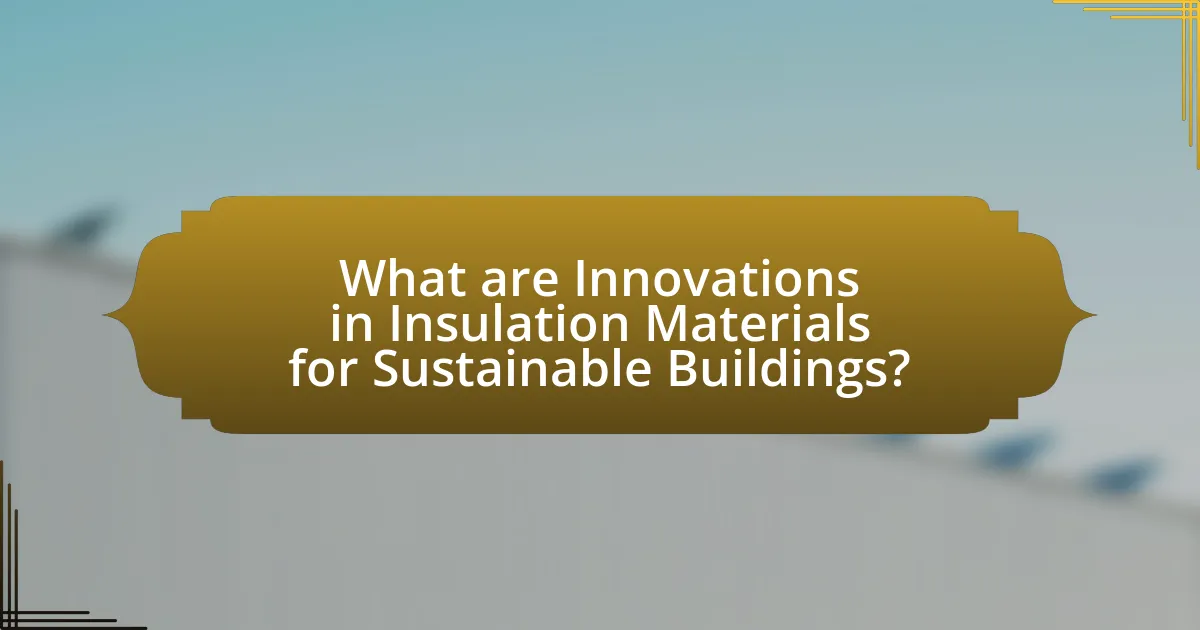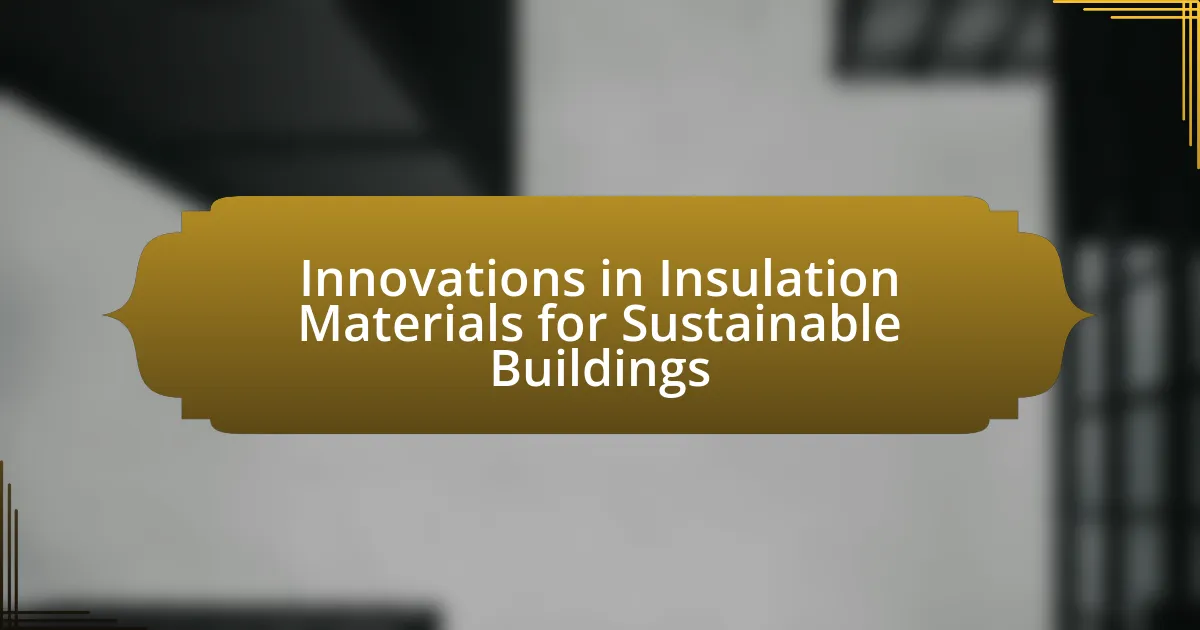Innovations in insulation materials for sustainable buildings focus on the development of bio-based and advanced synthetic options that enhance energy efficiency and reduce environmental impact. Key materials include cellulose, aerogels, and vacuum insulation panels, which provide superior thermal performance and lower energy consumption compared to traditional insulation. The article examines the sustainability benefits of these materials, the challenges in their adoption, and their role in meeting building codes and green certifications. Additionally, it highlights future trends in insulation technology and best practices for selecting appropriate materials for construction projects.

What are Innovations in Insulation Materials for Sustainable Buildings?
Innovations in insulation materials for sustainable buildings include the development of bio-based insulations, such as hemp, cellulose, and sheep’s wool, which offer renewable and environmentally friendly alternatives to traditional materials. These bio-based options not only reduce carbon footprints but also enhance energy efficiency by providing superior thermal performance. For instance, cellulose insulation, made from recycled paper, can achieve R-values of 3.1 to 3.8 per inch, demonstrating effective thermal resistance. Additionally, advancements in aerogel technology have led to ultra-thin, lightweight insulation with exceptional thermal properties, achieving R-values up to 10 per inch, making it ideal for space-constrained applications. These innovations contribute to the overall sustainability of buildings by minimizing energy consumption and utilizing renewable resources.
How do these innovations contribute to sustainability?
Innovations in insulation materials contribute to sustainability by enhancing energy efficiency in buildings. These advanced materials, such as aerogels and phase change materials, significantly reduce heat loss and gain, leading to lower energy consumption for heating and cooling. For instance, studies show that buildings utilizing high-performance insulation can achieve energy savings of up to 30% compared to traditional materials. Additionally, many of these innovations are made from recycled or renewable resources, further minimizing environmental impact and promoting a circular economy.
What are the environmental impacts of traditional insulation materials?
Traditional insulation materials, such as fiberglass, foam board, and cellulose, have significant environmental impacts primarily due to their production processes, resource consumption, and end-of-life disposal. The manufacturing of fiberglass insulation, for instance, involves high energy consumption and the release of greenhouse gases, contributing to climate change. Additionally, foam board insulation often contains hydrofluorocarbons (HFCs), potent greenhouse gases that can remain in the atmosphere for decades.
Cellulose insulation, while made from recycled paper, requires chemical treatments that can be harmful to the environment if not managed properly. Furthermore, traditional insulation materials can contribute to waste in landfills, as many are not recyclable or biodegradable. According to the U.S. Environmental Protection Agency, construction and demolition debris, including insulation, accounts for approximately 25-30% of total waste in landfills. These factors highlight the need for more sustainable insulation alternatives that minimize environmental harm.
How do innovative materials reduce energy consumption?
Innovative materials reduce energy consumption by enhancing thermal insulation and improving energy efficiency in buildings. These materials, such as aerogels and phase change materials, provide superior insulation properties that minimize heat transfer, thereby reducing the need for heating and cooling systems. For instance, aerogels can achieve thermal conductivity as low as 0.013 W/m·K, significantly outperforming traditional insulation materials. This reduction in heat loss or gain leads to lower energy demands for temperature regulation, resulting in decreased overall energy consumption in sustainable buildings.
What types of innovative insulation materials are currently available?
Innovative insulation materials currently available include aerogel, vacuum insulation panels (VIPs), and cellulose insulation. Aerogel, known for its exceptional thermal resistance, is made from silica and can achieve R-values exceeding 10 per inch. Vacuum insulation panels, which consist of a rigid core encased in a vacuum-sealed envelope, provide high thermal performance with minimal thickness, making them suitable for space-constrained applications. Cellulose insulation, derived from recycled paper products, offers an eco-friendly option with good thermal performance and soundproofing capabilities. These materials contribute to energy efficiency and sustainability in building design.
What are the characteristics of bio-based insulation materials?
Bio-based insulation materials are characterized by their renewable origins, sustainability, and effective thermal performance. These materials, derived from natural sources such as plant fibers, agricultural by-products, and recycled organic materials, contribute to reduced environmental impact compared to conventional insulation options. For instance, materials like cellulose, made from recycled paper, and hemp insulation, showcase excellent thermal resistance and moisture regulation properties. Additionally, bio-based insulation often has lower embodied energy, meaning it requires less energy to produce, which further enhances its sustainability profile. Studies indicate that using bio-based insulation can significantly lower greenhouse gas emissions in building construction, supporting the transition to more eco-friendly building practices.
How do advanced synthetic materials compare to traditional options?
Advanced synthetic materials outperform traditional options in insulation performance, durability, and environmental impact. For instance, materials like aerogel and vacuum insulation panels provide superior thermal resistance, often exceeding R-values of traditional fiberglass or foam insulations. Additionally, advanced synthetics are typically lighter and more moisture-resistant, reducing the risk of mold and structural damage over time. Research indicates that synthetic materials can also be produced with lower embodied energy, contributing to more sustainable building practices. For example, a study published in the Journal of Building Physics highlights that advanced synthetic insulations can reduce energy consumption in buildings by up to 30% compared to traditional materials.
What are the challenges in adopting innovative insulation materials?
The challenges in adopting innovative insulation materials include high initial costs, limited availability, and regulatory hurdles. High initial costs can deter builders and homeowners from investing in advanced materials, as traditional insulation options often present a lower upfront expense. Limited availability of innovative materials in the market can restrict options for consumers and builders, making it difficult to source these products. Regulatory hurdles arise from building codes and standards that may not yet accommodate new materials, leading to complications in compliance and approval processes. These factors collectively hinder the widespread adoption of innovative insulation solutions in sustainable building practices.
What are the cost implications of using new insulation technologies?
The cost implications of using new insulation technologies generally involve higher initial investment but can lead to significant long-term savings. Advanced insulation materials, such as aerogels and vacuum insulation panels, often have a higher upfront cost compared to traditional materials like fiberglass or foam. However, these new technologies provide superior thermal performance, which can reduce energy consumption for heating and cooling by up to 50%, as indicated by studies from the U.S. Department of Energy. Over time, the energy savings can offset the initial costs, making these technologies economically viable for sustainable building projects.
How do building codes and regulations affect the use of innovative materials?
Building codes and regulations significantly influence the adoption of innovative materials in construction. These codes establish safety, performance, and sustainability standards that new materials must meet to be approved for use. For instance, the International Building Code (IBC) outlines specific requirements for fire resistance, structural integrity, and energy efficiency, which innovative insulation materials must comply with to gain acceptance in the market. Compliance with these regulations can either facilitate or hinder the integration of advanced materials, as developers may face challenges in meeting stringent criteria or may need to conduct extensive testing to demonstrate compliance.
How can the construction industry benefit from these innovations?
The construction industry can benefit from innovations in insulation materials by achieving enhanced energy efficiency and reduced environmental impact. Advanced insulation materials, such as aerogels and phase change materials, provide superior thermal performance, which can lead to lower energy consumption for heating and cooling in buildings. For instance, studies have shown that buildings utilizing high-performance insulation can reduce energy costs by up to 30%. Additionally, these innovations often incorporate sustainable materials, contributing to a decrease in carbon footprint and promoting eco-friendly construction practices. This alignment with sustainability goals not only meets regulatory requirements but also appeals to environmentally conscious consumers, thereby enhancing market competitiveness.
What role do insulation innovations play in green building certifications?
Insulation innovations significantly enhance green building certifications by improving energy efficiency and reducing environmental impact. Advanced insulation materials, such as aerogels and recycled content products, contribute to lower energy consumption for heating and cooling, which is a critical criterion in certifications like LEED and BREEAM. For instance, buildings utilizing high-performance insulation can achieve up to 30% energy savings compared to traditional materials, directly influencing their certification scores. Furthermore, these innovations often incorporate sustainable manufacturing processes and materials, aligning with the principles of green building practices and further supporting certification requirements.
How can builders effectively integrate new insulation materials into projects?
Builders can effectively integrate new insulation materials into projects by conducting thorough research on the materials’ properties and performance characteristics. This involves evaluating factors such as thermal resistance, moisture control, and environmental impact to ensure compatibility with existing building systems. For instance, studies have shown that materials like spray foam and cellulose can significantly enhance energy efficiency when properly applied, leading to reduced heating and cooling costs. Additionally, builders should collaborate with manufacturers to receive training on installation techniques and best practices, which can further optimize the performance of these innovative materials.
What future trends can we expect in insulation materials for sustainable buildings?
Future trends in insulation materials for sustainable buildings include the increased use of bio-based and recycled materials, enhanced thermal performance, and smart insulation technologies. Bio-based materials, such as hemp, cellulose, and mycelium, are gaining popularity due to their low environmental impact and renewability. Recycled materials, like denim and glass wool, are being utilized to reduce waste and promote circular economy principles. Enhanced thermal performance is achieved through innovations like aerogels and vacuum insulation panels, which provide superior insulation with thinner profiles. Additionally, smart insulation technologies that adapt to environmental changes are emerging, allowing for improved energy efficiency and comfort in buildings. These trends are supported by the growing demand for sustainable construction practices and regulatory frameworks promoting energy efficiency.
How is technology shaping the development of new insulation solutions?
Technology is significantly shaping the development of new insulation solutions by enabling the creation of advanced materials that enhance energy efficiency and sustainability. Innovations such as aerogels, which are highly effective thermal insulators, and phase change materials, which regulate temperature by absorbing and releasing heat, exemplify how technology is improving insulation performance. Additionally, the integration of smart technologies, like sensors that monitor temperature and humidity, allows for adaptive insulation systems that optimize energy use in real-time. These advancements are supported by research indicating that modern insulation materials can reduce energy consumption in buildings by up to 30%, thereby contributing to more sustainable building practices.
What are the potential impacts of climate change on insulation material innovation?
Climate change is likely to drive significant innovation in insulation materials by necessitating higher energy efficiency and sustainability standards. As global temperatures rise, there is an increasing demand for materials that can effectively reduce energy consumption in buildings, leading to the development of advanced insulation solutions such as aerogels and bio-based materials. Research indicates that the construction sector is responsible for approximately 39% of global carbon emissions, highlighting the urgent need for improved insulation to minimize energy use and carbon footprints. Furthermore, climate change impacts, such as extreme weather events, will require insulation materials to be more resilient and adaptable, prompting innovations that enhance durability and performance under varying environmental conditions.
What best practices should be followed when selecting insulation materials?
When selecting insulation materials, prioritize energy efficiency, environmental impact, and suitability for the specific application. Energy efficiency can be assessed through the material’s R-value, which measures thermal resistance; higher R-values indicate better insulation performance. Environmental impact should be evaluated by considering the material’s sustainability, such as whether it is made from renewable resources or has a low carbon footprint. For example, materials like cellulose and sheep’s wool are both sustainable and effective. Additionally, ensure that the insulation material is appropriate for the climate and building type, as different environments may require specific properties, such as moisture resistance or fire safety. Following these best practices leads to improved energy performance and sustainability in building projects.

Leave a Reply